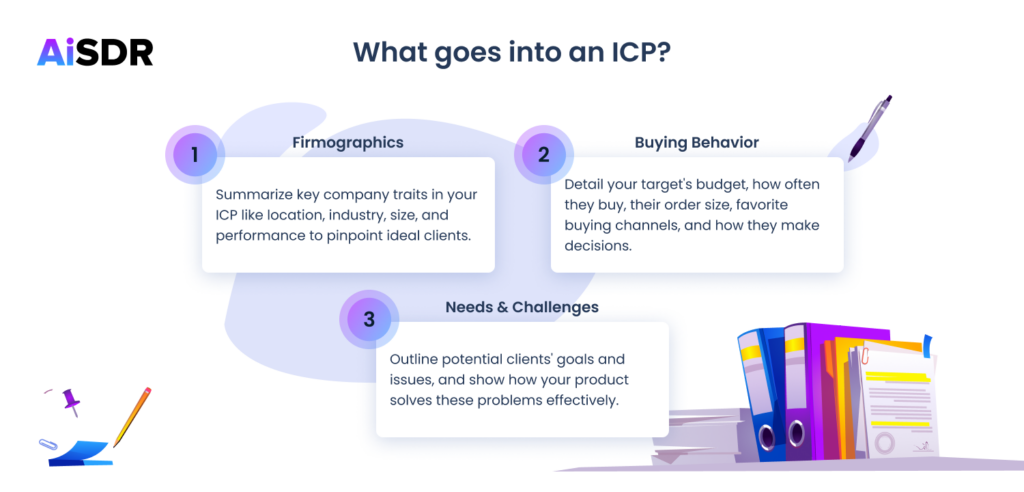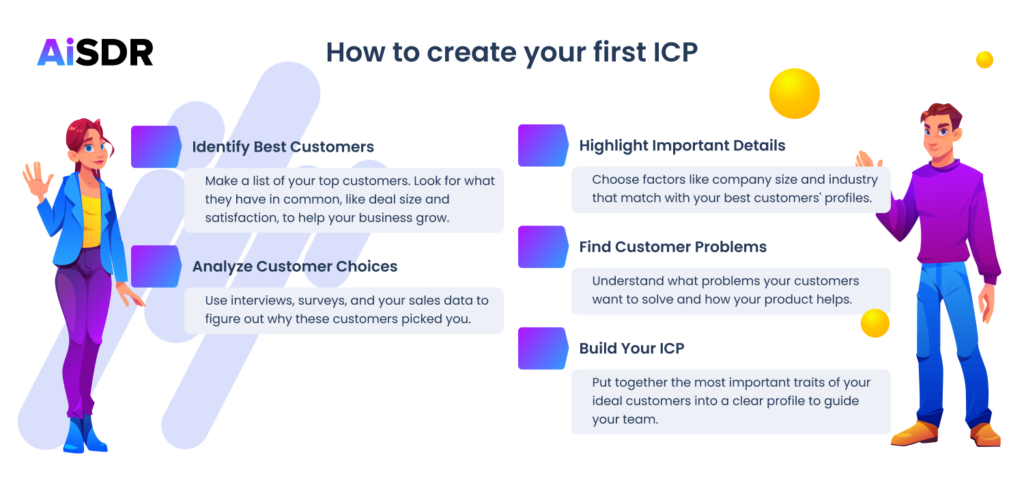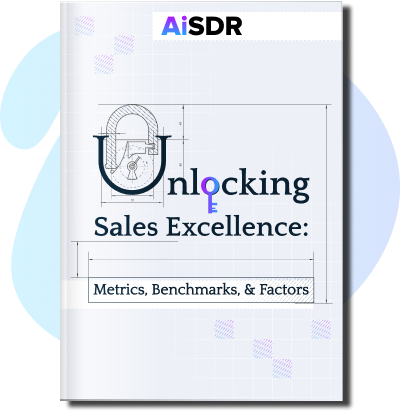Ideal Customer Profile: What is It and How Does It Benefit Your Business?

An unabriged guide to creating ICPs that drive your business forward, at scale
What type of businesses do you want to sell to? Entrepreneurs? Start-ups? Enterprises? Maybe a mix of sizes? Or where are most of your clients located? Which industries are they in?
No marketing and sales strategy will perform well unless you know who you’re selling to. If you can’t answer the questions above, your sales strategy has a good chance of stalling before it even gets started. In B2B marketing, this is where an ideal customer profile (ICP) comes into play.
In contrast to a buyer persona, an ICP focuses on which organizations are a good match for your product.
And just like crafting a sales persona, developing an ICP is one of the most important steps in creating a sales strategy as it gives sales and marketing teams the scope they need to use for targeting the right prospects and composing resonant messages. You can also use an ICP as an input to AI tools for nurturing leads like AiSDR or as a means to teach your AI what you’re looking for.
In this article, we’ll explore the specifics of ICPs, their benefits, and the best way to use them.
What is an ICP?
An ideal customer profile defines the budget, company size, location, and other attributes that can make a business more receptive to your offering. It involves creating a fictitious company that describes what your best customer looks like.
A carefully crafted ICP helps your marketing and sales teams hone in on leads that are more likely to convert. For example, if you’re selling solutions that only enterprise-level companies can afford, there’s little reason to waste resources chasing smaller companies without the necessary budget.
What’s the meaning of ICP in sales?
While marketing teams are busy working on goals like raising brand awareness and establishing thought leadership, sales teams are moving in for the kill. An ICP helps sales representatives maintain a tunnel vision and allocate more resources to promising prospects. This is helpful for B2B sales, which involve long buyer journeys.
The B2B sales process is so resource-intensive that it’s simply imperative that the sales teams focus on leads that are much more likely to bring in revenues.
With a well-crafted ICP serving as a guide, teams are better equipped to prepare effective sales emails, pitches, proposals, and demos. You’ll find it particularly useful if you’re engaging in account-based marketing (ABM), a strategy that concentrates resources on specific accounts. You’ll know just how to choose the right accounts to prioritize and find the best way to align your offering with the target clients’ pain points.
Now that we’ve tackled the question of what is ICP in business, it’s time to discuss a related concept – customer profiling. A customer profile compiles information, such as firmographics and buying behavior, that will be useful as you create your ICP.
What is Customer Profiling?
Customer profiling leverages data to get to know your existing customers. It takes into account firmographic, psychographic, geographic, and behavioral data.
While the ICP delves into the fictitious and aspirational, a customer profile describes your actual customers. Instead of concerning yourselves with ideal attributes, you closely study the data to gain insights and truly understand your customers. How are they using your products? What drives them? How can you better serve them?
Customer profiling keeps you grounded and enables you to pivot to more profitable directions. For instance, you may have started out aiming to provide large law firms with a contract lifecycle management system, only to find out that many of your customers are actually smaller businesses using the tool to store and manage their documents. With this insight, you can employ it to shape product development, pricing, and prospecting.
As you can see, customer profiling can help you identify and assess your best customers, which are key steps to creating your ICP.
What are the benefits of a customer profile?
You can’t get an ideal definition of customer profiling without mentioning its benefits.
Here are the advantages you gain when you take the time to research and understand your customers.
Improves decision-making
Relying on preconceptions can lead to costly mistakes. You could be marketing and improving product features that don’t matter much to your customers. And your sales teams could be focused on the wrong accounts, falsely assuming your product is appealing to a specific type of business. Because customer profiles are data-driven, they help your teams make smarter decisions regarding sales, marketing, or product development.
Boosts customer acquisition and retention
With a deeper understanding of the customers already patronizing your products, you get to target the right prospects and win over more new leads. You also get better at delivering customer services, allowing you to retain your existing users.
Increases profitability
With customer profiles steering your teams in the right direction, you can optimize resources and reduce expenses. By acquiring and retaining more customers you’re also increasing your business profits.
Customer profiling can be quite time-consuming, but the payoff makes all the hard work worth it in the end.
Customer profiling process
It’s time to get down to the nitty-gritty of creating a customer profile.
Here are the steps you’ll need to follow:
- Examine your existing customer data – Start by digging up the information you already have in your CRM or other similar software. You can use analytics software to make sense of available data.
- Gather information from your customers – You can ease the data-gathering process by using survey tools such as SurveyMonkey and KeySurvey.
- Put the data into context – Revisit your customer journey and analyze how your customers interact with your brand at every touchpoint. Contextualizing your data enables you to analyze how your brand is delivering a good customer experience.
- Put it all together in a document – Simplify the process by preparing a customer profile template. They serve as a guide that helps you identify the most important and relevant details.
Once your customer profile is ready, you’ll see just how ICP marketing can enable your sales efforts.
What goes into an ICP?
As valuable as an ICP is, it’s only as effective as the data you include. To that extent, in order for your ICP to help you target the right customers, it has to describe customers’ main attributes.
There are three primary factors to consider:
- Firmographics – The corporate counterpart of demographics, firmographics refers to the key attributes of a company, such as its location, industry, type of organization, number of employees, company size, and financial performance.
- Buying behavior – Your ICP should identify your target company’s buying behaviors and patterns, such as their budget, purchase frequency, purchasing cycle, average order value, preferred channels, and decision-making process.
- Needs and challenges – Your ICP should also specify the goals, pain points, and challenges of your target customers, as well as how your product might address them.
You can include other things in your ICP, such as the ideal tech stack. For instance, if your product only supports a native Gmail integration, then there’s no need to spend resources on companies that use Outlook or other email service providers.
In the end, the main goal of an ICP is to provide you with a better understanding of your customers so you can target them more effectively.

How an ICP benefits your business operations
While ICPs are often associated with sales and marketing teams, they’re not the only departments helped out by a good ICP. In fact, if your ICP is well-defined, it can drive several processes within your business.
Product development
If you’re an IT company, then your software developers are the ones who are ultimately responsible for implementing the product. An ICP can provide them with valuable guidance on questions like these:
- Which features work best for your customers?
- How can you make the most of your features?
- Are there any new features that you can introduce to boost customer satisfaction?
- Which features are the most “in demand” by potential customers?
Your ICP enables a feedback loop that aligns your products and services with your customers’ needs and preferences.
Pricing
The only way to ensure your company’s long-term success and health is to maintain financial stability and profitability. In other words, you need to make money.
Your pricing strategy needs to align with the customer’s perception of its value, i.e. how much your product or service is worth to your customers and how much they’re willing to pay. If your price is too high, no one will buy your product, but if the price is too low, you run the risk of financial losses.
Your ICP helps by showing you the dynamics that influence your customers’ buying decisions – What are their goals? Can your solutions help them overcome any challenges? Will budget constraints be an obstacle?
Factors like company size, financial performance, and pain points are useful for determining the right packaging and pricing for your product or service. If you visit various pricing pages of different companies, you’ll find they often price their products by size.
Prospecting
A good ICP can help you identify and prioritize the prospects that can bring in the most value to your business. This in turn can lead to a faster sales cycle and higher conversion rates since you’re focusing on companies who are more likely to want or need your product. It also enables you to feed AI tools for nurturing like AiSDR with segmentation data.
Benefits of an ICP for sales and marketing
As we mentioned earlier, ICPs are well-known for how they can drive your sales and marketing strategies. Here are some of the benefits of adopting the use of ICPs.
More efficient and targeted campaign development
Because your ICP clearly defines your prospective customers, it gives you a strong foundation for basing your go-to strategies and tactics.
Need to decide which marketing channels to prioritize? How about which sales pitch works best? With an ICP to answer these relevant questions, it’s easier to create and adjust your marketing and sales campaigns. You can even feed your ICP into generative AI to automate email campaigns and nurture your leads.
More focused content marketing
An ICP can rev up inbound marketing with more engaging content that speaks the exact language of your target audience. It’s pull marketing done right.
And if you use an AI marketing tool like AiSDR, you can use your ICP as the basis for launching tailored inbound and outbound campaigns that are more likely to convert.
Reduced churn
Your ICP doesn’t just help you target the right prospects. It also allows you to focus on retaining existing customers who are likely to find the most value in your product. You’ll be able to provide value-added services that ensure customers stay loyal to your brand.
Drawbacks of an ICP
Despite its benefits, a poorly defined or poorly used ICP can stall your progress and lead to wasted time and resources. Similar to common sales persona mistakes, erroneous ICPs can set back your campaigns for weeks, if not months.
Here are some of the dangers you should watch out for and keep in mind.
Narrow customer focus
The inherent nature of an ICP means that you’re focusing on a very specific market segment. On the one hand, this can enable higher conversion among the customers included in the ICP. On the other hand, you risk omitting companies who might have purchased your product otherwise, resulting in lost potential revenue.
You can mitigate this problem by creating different ICPs for different customer segments, whether they’re segmented by size, location, or industry. With multiple ICPs, you can tailor campaigns and send personalized messages without excluding prospects.
Narrow market focus
There’s also the risk of tunnel vision with regards to your ICP. An ICP is meant to be a tool that can be easily adjusted to reflect the evolution of your market and industry. If you stay married to your ICP, chances are you’ll fall behind or miss out on lucrative markets. You can avoid this by regularly revisiting your ICP to tweak and improve it.
To ensure you’re making the right improvements, always gather customer feedback and stay abreast of market and industry trends. You can run surveys, conduct interviews, and monitor feedback channels. It also helps to follow top news and resources in your industry, leverage tools like Google Trends, and watch what your competitors are doing.
How to create your first ICP
A deep dive into how to build an ICP merits its own blog post. For now, here’s a “quick & dirty” rundown on how you can create an ICP.

Identify your best customers
Start by drafting a list of your best customers, then look for similarities that indicate what makes them so good from your company’s perspective.
Here are some attributes to consider:
- Profitable deals
- Lifetime value
- Satisfaction levels
- Openness to upselling and cross-selling
- Contract duration
- Contract renewals
- Customer referrals
At this stage, your aim should be to determine which attributes will grow your bottom line. Once you’ve found them, your job is to prioritize them accordingly.
Analyze your best customers
Next, you need to learn what drove your best customers to choose your business. You can use these tactics and resources to collect information and data for your analysis:
- Face-to-face or virtual customer interviews
- Customer surveys
- Customer-facing employees
- Sales and marketing heads
- CRM systems
- Help desk systems
- Industry news and reports
Now that you’ve identified why your best customers are your best customers, you should have a clearer idea about the leads and prospects you can start to target.
Identify key attributes
Armed with your deeper understanding of your customers, it’s time to highlight which attributes to include in your ICP.
The list will usually include firmographics like company size, location, growth rate, and technology stack. Researching your customers’ goals and market situation will help you decide which attributes carry more weight, which to include, and which to omit.
Determine customer pain points
Using the insights gained from your customer research, you’ll next need to pinpoint the crucial pain points that negatively impact your customers.
Here are some questions you’ll need to consider:
- What motivates your customers?
- What challenges are they trying to overcome?
- What are their expectations from your products?
- How are you meeting them?
With all these answers in hand, you’re ready to craft your ICP.
Create your ICP
The final step is to bring everything together in a single document or other tool. Choose an easy-to-understand format that accommodates at least ten key characteristics.
There’s no prescribed template for an ICP. As long as the format is helping teams across your business make smarter decisions, it’s doing its job.
Ideal customer profile template
Even though there’s no recommendation for a one-size-fits-all ideal customer profile template, it’s still a good idea to have one at hand. You have two options:
- Design your own so that it meets your company’s unique needs
- Search for and choose one from the many downloadable ICP templates online.
Your template may include questions you can simply answer, such as “What stage of growth is the company in?” and “What is its most pressing problem that your business solves?” It may also itemize the information you’re supposed to fill in, such as the company size and annual revenue.
Your template should help you ask the right questions and fill in the most relevant information. Its presentation should be clean and straightforward, so users from different departments won’t have any problem understanding what it tries to relay.
Remember that your ICP will evolve alongside your company, so make sure you come up with a template that’s easy to update.
Leverage your ICP to find the right customers
An ideal customer profile helps you effectively discover and reach out to prospects, win over new customers, and retain existing clients. This is because it clearly outlines their needs, goals, and deciding factors while allowing you to fine-tune your sales and marketing strategies so they resonate with your target audience.
All companies will find ICPs useful, especially new startups and small businesses that are in the earlier stages of their life. Even companies such as Google, Netflix, and Microsoft turn to ICPs to inform strategic decisions regarding the pricing of new products.
With an ICP in hand, your teams can leverage sales automation tools like AiSDR to boost their performance and speed up critical work like qualifying leads, nurturing potential clients, and automating correspondence.
Book a demo to discover how your team can benefit from AiSDR.
FAQ
What is an ideal customer profile?
An ideal customer profile defines which businesses or companies are most likely to take an interest in your product or services.
Why are ideal customer profiles important?
An ideal customer profile empowers your teams to create and scale targeted sales and marketing campaigns, craft tailored content, and provide value-added services to retain customers. It also helps you decide on a pricing strategy, execute lead generation and prioritization, and align product development with customer needs.
What information should ideal customer profiles include?
Your ideal customer profiles should include key company attributes such as location, size, industry, profitability, buying behavior, needs, and pain points.
How do ideal customer profiles help sales and marketing campaigns?
An ideal customer profile gives sales and marketing teams insights to create content and pitches that speak to the right audience. It also helps them filter out irrelevant prospects and focus their efforts on those who are more likely to engage with their campaigns.











